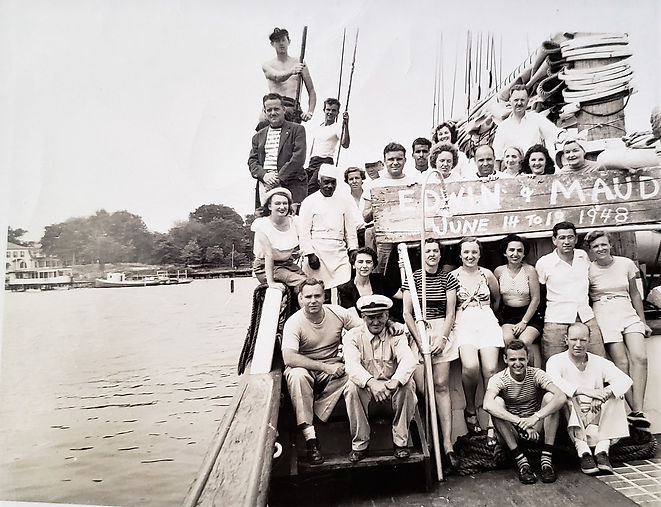Last of its kind schooner, first of its kind venue
Last of its kind schooner, first of its kind venue
Last of its kind schooner, first of its kind venue

Learn
Victory Chimes
History
From Work to Play
The Golden Age of Sail had gone over the horizon, and after WWII, cargo by sail brought diminishing returns. We've all seen old farm equipment in a field and work trucks long still "put out to pasture" and sinking into their last parking spots. So it was with many old cargo ships. Often old ships were tied up, dismantled, or just scuttled.
These ships were built so strong to handle hard work though, that when they were no longer useful, some still had life left in them.
Career of EDWIN AND MAUD as a Cargo-Carrying Ram
Originally home ported in Seaford, Delaware,35 Edwin And Maud spent much of her working career as a freighter out of Baltimore, owned by C.C. Paul & Co. and Albert F. Paul, normally carrying a crew of four.36 C.C. Paul was one of Baltimore's largest grain brokers, dealing mainly in corn and wheat.37
When Edwin And Maud carried fertilizer, which was carried bagged on the smaller schooners, recalled William Stevens:
"We never ran many bags...We carried it loose in her hold."38 Stevens also stated that "whenever we'd load grain or fertilizer in the hold we'd always seal the hatches. Sometimes on the Edwin and Maud, the water'd be coming across and you could have rowed a skiff around on deck if it weren't so rough. Of course we didn't mind 'cause she was a nice boat."39
Stevens and his father made several trips to North Carolina in the three years they sailed the ram, carrying fertilizer or soft coal down
click to enlarge.
"We'd load the Maud with dry lumber until she'd tilt"
When picking up their return cargo of lumber, it was "loaded by hand and carefully distributed. If it was dry,a third of it was placed in the hold and two-thirds on deck. A load of green lumber was split half and half and it was often so heavy that, instead of figuring the rate by board feet, the captain charged a flat rate for the load.40
click to enlarge
"We'd load the Maud with dry lumber until she'd tilt,"said Stevens. "When she'd tilt a little bit, we knew we could only put on another 4,000 or 5,000 feet. We'd pile it eight feet on deck and could hardly see over it standing on the quarterdeck."41
On the return trip the yawl boat was critical, as on occasion Stevens and his father sailed EDWIN AND MAUD by themselves.
"We carried 750 gallons of gas and we hauled it over the stem to the yawl boat, 20 gallons at a time. That was all right when the Maud was loaded, because you didn't have to step far, but when she was light we'd have to get a ladder."42
Stevens and his father worked Maud until 1946. That's when the ship went from work to play. Read on and let the fun begin.

Career of EDWIN AND MAUD as a Chesapeake Bay Windjammer
When William Stevens and his father could not make any more money running freight under sail, the ship was sold by its owners"43 In 1946 Herman Knust bought EDWIN & MAUD for his Chesapeake Bay Vacation Cruises.44 Edwin And Maud had carried cargo for forty-six years. It was time for her relax a bit, not retire but repurpose.
There had been several attempts at operating "dude" schooners on Chesapeake Bay, beginning shortly before the outbreak of World War II, but they had not been notably successful. On the Bay, shortly before the war, Captain D'Arcy Grant began passenger operations with the seventy-three foot, two-masted schooner Henry Disston, but by 1945 she had been abandoned.
For a neat side-story about the Disston house being haunted, click here and go to #10.
Another attempt with the schooner Edward L. Martin ended when she was converted to power in 1943.45 In 1944 Knust acquired the ram schooner Levin J. Marvel, investing a reported eighteen thousand dollars in her purchase and conversion to passenger service. Two years later headed Edwin And Maud. Cruises varied from five days to two weeks, and the two schooners were operating at ninety percent capacity during the June to October cruising season.46
In 1954, Knust sold off his schooners; Marvel to a Pennsylvania entrepreneur, and Edwin & Maud to a Maine syndicate. In August 1955, Marvel was lost in a hurricane on Chesapeake Bay with the loss of fourteen lives. 47a The Coast Guard inquiry blamed Marvel's poor condition and bad judgement on the part of her owner/captain.47 It would be another twenty years before passenger service returned to the Bay.
And now, as you've surely noticed, the mood of the content around this history has changed. We're at the windjammer era of the ship's history! We're really going to start showing off the contributed content we've gotten from folks. Actually, we've been slowly changing the style the whole time, from old school to modern with different fonts and subtle color choices.
Start the trip by enjoying the parade of brochure material below. It's from the ship's time roaming the Chesapeake Bay as a windjammer in the late 1940s and early 1950s.
click images to enlarge
Chesapeake Bay Windjammer
This material is from Captain Stevens' grandson, John Webster
1947 - At anchor in Irvington VA
Imagine having TWO three-masted schooners! Herman Knust bought the LEVIN J MARVEL IN 1944 and added EDWIN & MAUD in 1946.


We still do this today! Not paint a big sign with the date on it at the end of every trip, but take a group picture.
Painting by Louis Fechter, 1948






NEXT PAGE: Maine Windjamming







.jpg)